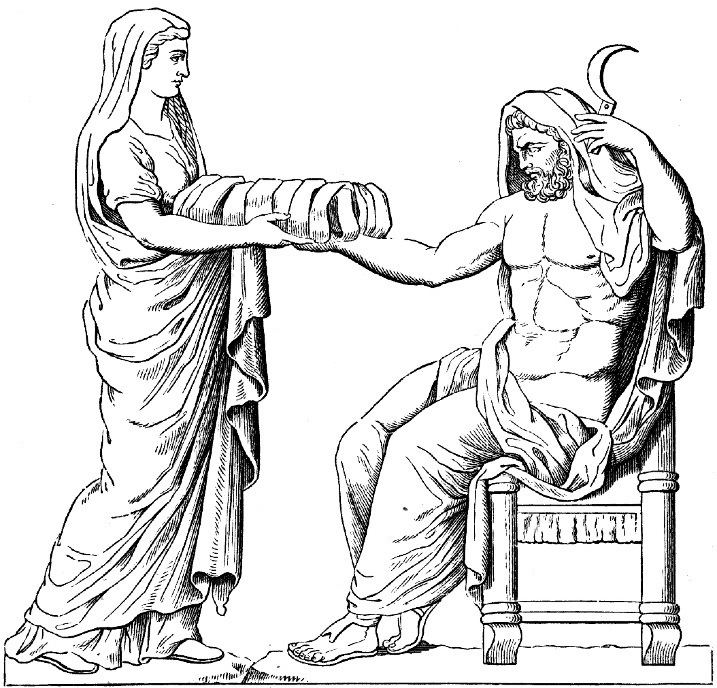Other names Cybele, Meter Theon Animals Lion Tree Fir tree | Symbol Turret crown, cymbal | |
 | ||
Rhea (/ˈriːə/; Greek: Ῥέα, [r̥é.a͜a]) is the Titaness daughter of the earth goddess Gaia and the sky god Uranus, in Greek mythology and sister and wife to Cronus. In early traditions, she is known as "the mother of gods" and therefore is strongly associated with Gaia and Cybele, who have similar functions. The classical Greeks saw her as the mother of the Olympian gods and goddesses, but not as an Olympian goddess in her own right. The Romans identified her with Magna Mater (their form of Cybele), and the Goddess Ops.
Contents
Etymology
Most ancient etymologists derived Rhea ('Ρέα) by metathesis from έρα "ground", although a tradition embodied in Plato and in Chrysippus connected the word with ῥέω (rheo), "flow", "discharge", which is what LSJ supports. Alternatively, the name Rhea may be connected with words for the pomegranate, ῥόα, later ῥοιά.
The name Rhea may ultimately derive from a pre-Greek or Minoan source.
Genealogy and Myth
Cronus sired six children by Rhea: Hestia, Hades, Demeter, Poseidon, Hera, and Zeus in that order. Apart from Zeus, he swallowed all as soon as they were born, because he had learned from Gaia and Uranus that, as he had overthrown his own father, he was destined to be overcome by his own child. When Zeus was about to be born, however, Rhea sought Uranus and Gaia to devise a plan to save him, so that Cronus would get his retribution for his acts against Uranus and his own children. Rhea gave birth to Zeus in Crete, and saved him by handing Cronus a stone wrapped in swaddling clothes, which he promptly swallowed. Rhea hid Zeus in a cave on Mount Ida in Crete. Her attendants, the warrior-like Curetes and Dactyls, acted as a bodyguard for the infant Zeus, helping to conceal his whereabouts from his father.
Cult
Rhea had "no strong local cult or identifiable activity under her control". She was originally worshiped in the island of Crete, identified in mythology as the site of Zeus's infancy and upbringing. Her cults employed rhythmic, raucous chants and dances, accompanied by the tympanon (a wide, handheld drum), to provoke a religious ecstasy. Her priests impersonated her mythical attendants, the Curetes and Dactyls, with a clashing of bronze shields and cymbals. The tympanon's use in Rhea's rites may have been the source for its use in Cybele's–; in historical times, the resemblances between the two goddesses were so marked that some Greeks regarded Cybele as their own Rhea, who had deserted her original home on Mount Ida in Crete and fled to Mount Ida in the wilds of Phrygia to escape Cronus. A reverse view was expressed by Virgil, and it is probably true that cultural contacts with the mainland brought Cybele to Crete, where she was transformed into Rhea or identified with an existing local goddess and her rites.
Iconography
Rhea only appears in Greek art from the fourth century BC, when her iconography draws on that of Cybele; the two therefore, often are indistinguishable; both can be shown on a throne flanked by lions, riding a lion, or on a chariot drawn by two lions. In Roman religion, her counterpart Cybele was Magna Mater deorum Idaea, who was brought to Rome and was identified in Roman mythology as an ancestral Trojan deity. On a functional level, Rhea was thought equivalent to Roman Ops or Opis.
Most often Rhea's symbol is a pair of lions, the ones that pulled her celestial chariot and were seen often, rampant, one on either side of the gateways through the walls to many cities in the ancient world. The one at Mycenae is most characteristic, with a lioness placed on either side of a pillar that symbolizes the goddess (as seen in numerous images for goddesses throughout the ancient world where a tree or a column is used to represent the deity).
Depiction in ancient literature
In Homer, Rhea is the mother of the gods, although not a universal mother like Cybele, the Phrygian Great Mother, with whom she was later identified.
In the Argonautica by Apollonius of Rhodes, the fusion of Rhea and Phrygian Cybele is complete. "Upon the Mother depend the winds, the ocean, the whole earth beneath the snowy seat of Olympus; whenever she leaves the mountains and climbs to the great vault of heaven, Zeus himself, the son of Cronus, makes way, and all the other immortal gods likewise make way for the dread goddess," the seer Mopsus tells Jason in Argonautica; Jason climbed to the sanctuary high on Mount Dindymon to offer sacrifice and libations to placate the goddess, so that the Argonauts might continue on their way. For her temenos they wrought an image of the goddess, a xoanon, from a vine-stump. There "they called upon the mother of Dindymon, mistress of all, the dweller in Phrygia, and with her Titias and Kyllenos who alone of the many Cretan Daktyls of Ida are called 'guiders of destiny' and 'those who sit beside the Idaean Mother'." They leapt and danced in their armour: "For this reason the Phrygians still worship Rhea with tambourines and drums".
Modern namesakes
The name of the bird species rhea is derived from the goddess name Rhea.
The second largest moon of the planet Saturn is named after her.
